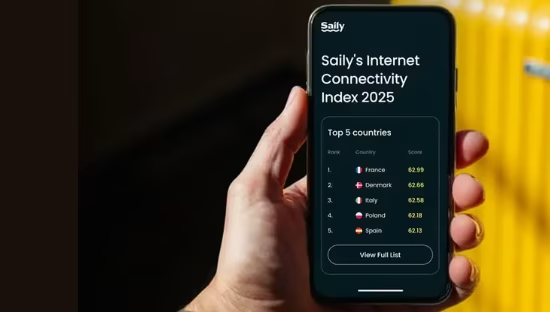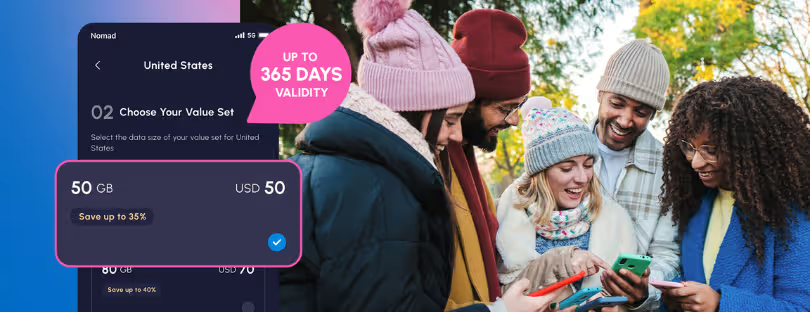
Travel Data Plans: Compare, Ask, or YOLO? Our Poll Reveals All
Travel is supposed to be about freedom — roaming new cities, tasting new food, and sharing that perfect photo from the other side of the world. But before any of that happens, there’s one modern-day ritual almost every traveler faces: buying a data plan.
Last week, I ran a poll with 801 votes, asking a simple question:
“How do you compare travel data plans before buying?”
The results were eye-opening, if not a little predictable:
- I use comparison websites — 13.33%
- I check app reviews — 13.33%
- I ask other travelers — 33.33%
- I don’t compare — I just buy — 40%
That’s right: almost half of travelers don’t bother comparing at all. They just… buy. Whether it’s the airport kiosk SIM, the first eSIM app that pops up, or whatever their mobile operator offers, many travelers go for the quick fix.
But let’s break down these habits a bit more honestly, because behind each choice is a travel personality we all recognize.
The Comparison Site Loyalists (13.33%)
These are the spreadsheet travelers. The ones who triple-check exchange rates before booking a flight. If you fall into this group, you probably love the thrill of knowing you squeezed out the very best deal.
Comparison sites make a lot of sense: they line up multiple providers and highlight coverage, price, and sometimes customer reviews. You can filter by country, data allowance, or duration, and feel like you’re making a perfectly rational choice.
But here’s the catch: not all comparison sites are created equal. Some are affiliate-driven (meaning they list who pays them), and some don’t update prices as frequently as they should. That means you might think you’re seeing “the cheapest,” but it’s really “the cheapest among those who paid to be listed.”
Still, this method works if:
- You’ve got time before your trip.
- You’re traveling to multiple countries and need to compare bundles.
- You want peace of mind knowing you “did your research.”
And let’s be real — there’s a tiny dopamine hit in knowing you got your data plan for €7 instead of €12.
The Review Checkers (13.33%)
Then there are the star-gazers. You trust the wisdom of the crowd — if the app has 4.6 stars on the App Store with glowing reviews, you’re in.
This approach has a big advantage: it’s human. Reviews give you unfiltered (sometimes overly emotional) insights into whether a data plan actually works. Coverage in rural Japan? Speed in Mexico? Customer support in Italy? Reviews often spill the tea.
But here’s the downside: reviews are noisy. Some people leave 1-star ratings because they couldn’t figure out how to install an eSIM. Others leave 5 stars because the app design is “cute” — not because the service was reliable.
If you’re a review-checker, you probably care less about saving €3 and more about avoiding frustration. You don’t want to be the person standing outside a café in Lisbon, angrily refreshing your WhatsApp because your “cheap” eSIM is crawling at 2G speeds.
Reviews help, but they’re a gamble. Like asking Yelp to pick your dinner spot — it works… until it doesn’t.
The Word-of-Mouth Travelers (33.33%)
Now, this group surprised me with its size: a full third of voters said they ask other travelers.
Honestly? It makes sense. If you’re in a hostel in Bangkok and someone says, “Don’t bother with XYZ SIM, it’s a rip-off—just buy the one at 7-Eleven,” you’re going to listen.
Travelers are natural storytellers, and word-of-mouth is one of the oldest and most reliable forms of consumer advice. People love to warn others about bad experiences and share hacks that saved them money.
If you’re in this group, you probably trust the “real-world test” over glossy marketing. You’d rather hear from someone who just used the plan last week than from a slick ad telling you it’s “the #1 global eSIM.”
The limitation? It depends on your circle. If you ask your parents or a co-worker who last traveled in 2018, their advice may not be relevant. And if you’re traveling somewhere niche—say, Madagascar or rural Patagonia—your traveler friends might not have the firsthand scoop.
Still, this method feels the most human. It’s connection-based, and in travel, connection is everything.
The YOLO Buyers (40%)
And then we come to the biggest group: the “I don’t compare, I just buy” crew.
This honestly cracked me up, because it’s exactly what I’ve seen happen countless times in airports. You land, you’re tired, and you just want Google Maps to work, so you hand over €30 for a SIM you could’ve bought online for €8.
Or maybe you download the first eSIM app that appears in the App Store and hope for the best. Sometimes it works out great. Sometimes you’re stuck with spotty coverage and no customer support.
This approach is about time over money. For YOLO buyers, the value isn’t in saving €5 — it’s in not wasting 20 minutes comparing fine print. It’s about convenience, speed, and not overthinking it.
And hey, sometimes that’s the right call. Travel throws enough curveballs already — do you really want to stress about MB vs GB pricing while your friends are already ordering their first Aperol Spritz?
But here’s the flip side: this is also the group most likely to regret it later. Especially when they realize their plan ran out halfway through a trip, or they paid way more than necessary.
What These Numbers Really Tell Us
When I look at these results, the main takeaway isn’t that one method is better than another. It’s that choosing a travel data plan isn’t just a transaction — it’s a reflection of your travel personality.
- The YOLO buyer values speed and convenience above all.
- The traveler who asks around values trust and shared experience.
- The comparison site researcher values control and detail.
- The app review checker values signals of quality and usability.
And the truth is, most of us are a mix. Sometimes I’m the researcher, building a spreadsheet of eSIM providers before a big trip. Other times, I’m exhausted and just grab whatever plan pops up on Google. (Now you can check the best eSIM Finder with 100+ eSIM providers and their services).
Why This Matters More Than Ever
Here’s the kicker: travel connectivity is no longer optional. It’s the backbone of modern travel. Boarding passes live in apps. Maps live in your pocket. Restaurant reservations, translation tools, hotel check-ins — all of it depends on data.
So how you pick your plan really does matter. It’s not just about saving €20. It’s about whether you’ll be stuck hunting for Wi-Fi in a foreign city or smoothly navigating with 5G in your pocket.
And with the rise of eSIMs, the game has changed. You don’t need to buy a plastic SIM at a kiosk anymore. You can activate a plan before you even leave home, scan a QR code, and land connected. But that also means the choices have multiplied — dozens of providers, hundreds of plans, all with different fine print. No wonder people are divided on how to choose.
Quick eSIM 101: Why It’s Changing How We Buy Data Plans
If you’ve been traveling for years, you probably think of “data plans” as buying a physical SIM card at the airport. But that’s shifting fast. With an eSIM, you don’t need to hunt down a kiosk or swap plastic cards. You just scan a QR code, and boom — you’re connected.
The upside?
- You can compare and buy before you fly.
- No more wasting time (or money) at airport stands.
- Switching between countries or providers is way easier.
This is exactly why so many comparison sites and app reviews are focused on eSIM providers now. They’ve opened up dozens of new options — which is great, but also makes the choice more overwhelming.
So… What’s Your Move?
The poll shows there’s no one-size-fits-all answer. Some of us buy fast. Some of us compare obsessively. Some of us lean on fellow travelers. And honestly, that’s okay. What matters is knowing your own priorities:
- Do you want cheap? → Take time with comparison sites.
- Do you want reliable? → Ask other travelers.
- Do you want easy? → Just buy whatever’s first and move on.
- Do you want safe from app headaches? → Read those reviews.
At the end of the day, there’s no wrong way to do it. However, there is a smarter way, depending on the type of traveler you are.
So, next time you’re about to click “buy” on a travel data plan, take a second to think: am I making this choice because it’s the best option, or because it’s the easiest?
Either way, you’ll have Wi-Fi at the airport to figure it out. Hopefully.
Here is this week’s poll:
Now I want to hear from you. Be honest: how do you pick your travel data plan? Do you obsess, trust, ask, or YOLO it? Because one thing’s for sure — the way we connect while traveling says as much about us as the places we go.











